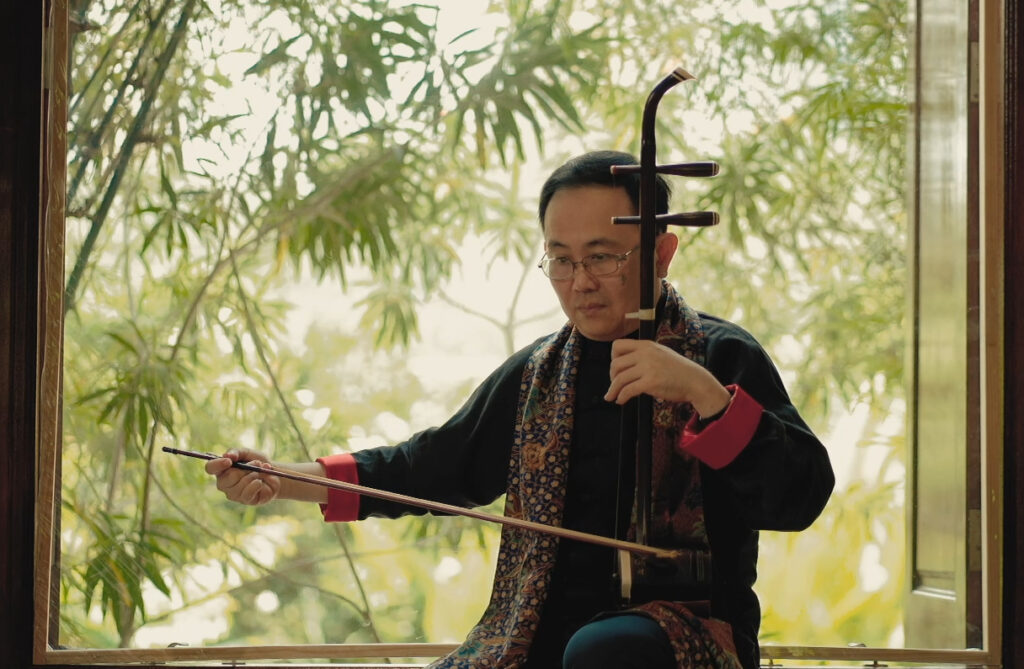TINGKAP PROJECT
The River Of Sorrow on ERHU
The River Of Sorrow on ERHU
performed by Lim Wei Xiong
“The river of sorrow”(Jianghe Shui)” was originally a traditional tune in the Liaonan drum music. It was adapted into a double reed instruments by the musician Gu Xinshan (1927-1992) in 1951. In the early 1960s, Huang Haihuai (1935-1967), a young teacher at Hubei Art Academy, transplanted the tune to erhu. He imitated the characteristics of the reed instrument playing by using techniques such as plucking, pressing, and rubbing the strings, combined with the rich and varied bowing techniques and the special technique of sliding between notes, occasionally alternating with direct playing (i.e., not rubbing the strings), conveying the melancholy and indignation of the music.

According to Wei Siong’s recollection, the first time he encountered “Jianghe Shui” was listening to a recording of the China Broadcasting Chinese Orchestra and erhu master Min Huifen (1945-2014). Later, because he planned to take the Grade 8 Erhu Performance examination, his erhu teacher Fang Liang demonstrated playing in class, giving Wei Siong an unforgettable musical touch. The seemingly simple melody used an unusual playing technique to bring out a thick emotion. From the moment he began to rub the strings, Wei Siong himself said that the emotions of sadness and indignation were like feelings that were trapped in his heart and could not come out.
Wei Xiong believes that the most crucial part of playing “Jianghe Shui” is the first note of the tune. This requires a full emotional build-up to pull off. The rest of the piece requires continuous changes in the bowing pressure on the right hand and the pressing force on the left hand, combined with the control of phasing breathing and the control of the volume, in order to achieve a balanced interpretation. Although the technical difficulty of this piece is not high, managing the music and emotions is more difficult. It requires layer upon layer of emotional arrangement and ups and downs, and different emotional contagions may occur when performing in different situations.
《江河水》原是一首遼南鼓樂中的傳統曲牌,由管樂演奏家谷新善(1927-1992)等人於1951年改編而成的雙管獨奏曲。60年代初,湖北藝術學院青年教師黃海懷(1935-1967)將此曲移植成二胡曲,模仿管子演奏的特點,運用吟、壓、揉等揉弦方法,配合豐富多變的弓法和氣滑音的特殊技巧,間或輔以直音(即不揉弦)的交替,傳達出樂曲淒涼、悲憤的情緒。
據偉雄回憶,第一次接觸《江河水》這首曲子是聆聽中國廣播樂團與二胡演奏家閔惠芬(1945-2014)的唱片錄音,之後因為計劃考取8級二胡演奏文憑,主課老師方亮在上課時親自示範拉奏,給了偉雄一次難以忘懷的音樂觸動。那看似簡單的旋律卻用了不尋常的拉奏手法來帶出那一抹厚重的情感。在摩擦琴弦那一刻開始,就偉雄自己說,那些哀怨與不憤等情緒像窩在內心出不來的感覺。
偉雄覺得演奏《江河水》最關鍵是曲子的第一個音符,這需要滿滿待噴發的情緒拉下,接下來全曲持續著右手上的拉弓力度和左手上的按弦力度變化,再配合段落呼吸和大小聲的控制,整體平衡拿捏到位才能很好的詮釋。雖說此曲技巧難度不算大,但樂曲的控制和情緒的把控卻比較難,它需要的是層層疊疊的情緒鋪排和起伏,而在不同場合表演的時候會有不同的情緒感染波動。
